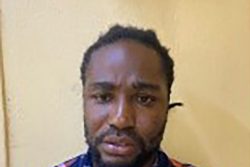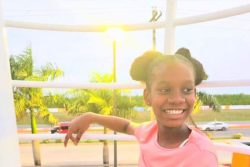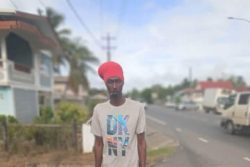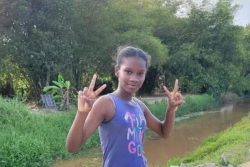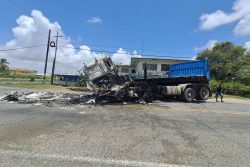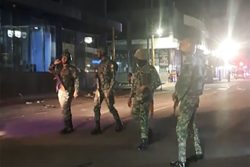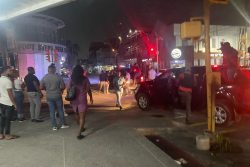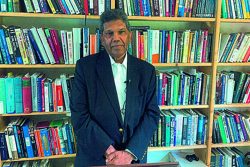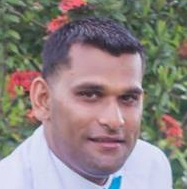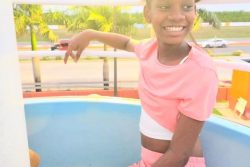By Henry Muttoo, Cayman Islands
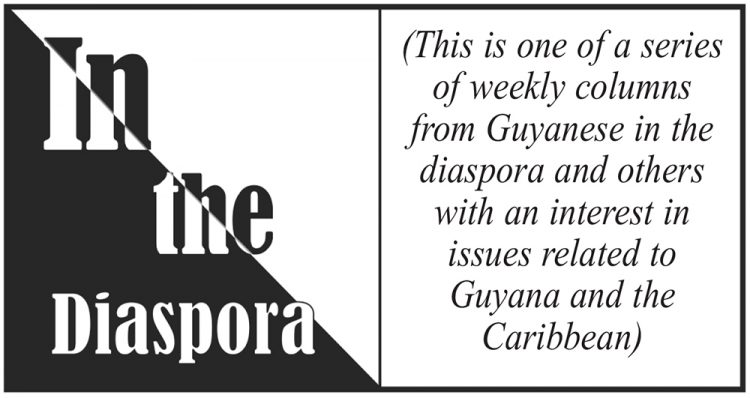 In his foreword to the 1963 publication, The Artist in West Indian Society, the eminent West Indian educator and novelist, John Hearne opined:
In his foreword to the 1963 publication, The Artist in West Indian Society, the eminent West Indian educator and novelist, John Hearne opined:
“The…true story of the West Indian artist for the past generation is a record of the anguished attempts to make our landscape symbolically significant.”
At the time Hearns penned those lines, the Theatre Guild of Guyana was just a fledgling three years old. Among its membership was a young, enthusiastic, would-be-dramatist whose creative sensibilities were grounded in a middle-class ‘range yard’ in one of the better wards in Georgetown. His name was Ken Corsbie. Under the guidance of the Guild’s many artists, technicians, managers, creative thinkers and dramatists, Corsbie’s natural gifts blossomed, and he rapidly moved from ordinary member and workshop attendee, to actor, dancer, technician, scholarship recipient, the first (and only) professional director of the organisation, to the most innovative, multi-talented and regionally recognised of all the Theatre Guild’s alumni.
Now, after 70 years of ‘symbolically signifying our landscape’, Ken Corsbie – who left Guyana after operating under a rapidly accumulating cloud of frustration over the treatment of artists by decision-makers with scant knowledge and closed ears, has exited peacefully, with his wife of 30 years, Dr. Elizabeth Barnum, at his bedside.
Much of Ken’s story in the theatre has been published in interviews he or others gave. I will not repeat those or tell you of his prowess in sports (see ‘He was beyond Basketball – Reds Perreira. Guyana Chronicle, 8/2/25).
Ken was much admired, loved and respected around the region for his tremendous body quality of work. Like any other artist, he was capable of temper tantrums but after the noise had faded, the matter was over and done with as far as he was concerned. And he never allowed differences, professional or personal, between himself and someone to stop him from praising the person’s work. Anyone who has seen him on stage will attest to the fact that the man had ‘presence’, an aura that drew people to him. He stood out, sometimes for his casual mode of dressing (often a short pants, shirt and leather sandals, which I recall caused Mrs. Lynette Dolphin – the then Director of the National History and Arts Council – great grief) but mostly it was his charm and wide-ranging theatre knowledge, his ability to hold an interesting conversation, tell a joke and his impish sense of humour. During his lifetime, Ken made many friends in Guyana, the Caribbean, USA and as far away as Africa, India, Australia and the UK. One such friend was Dr. Amina Blackwood-Meeks, Orator at the University of the West Indies, Mona, and unquestionably the region’s finest Storyteller. I share her tribute in its entirety:
THE MAGIC OF KEN CORSBIE: Homage to a guide.
Ken Corsbie was a magician. He released his magic to serve the Caribbean region, to serve the countries in which he was blessed to live and to serve individual theatre practitioners in their becoming.
At the regional level his contribution to amplifying our voice and presence at the world stage was a given. At the national level his service to Guyana, Barbados and everywhere else that he has made his home is uncontestable. At the personal level I have benefited from his magic since I was 15 years old. During my 15th year on earth Ken and Marc Matthews performed at St. Andrew High School for girls on one of their tours as Dem Two. Was it their sheer handsomeness in an audience of giggling young girls mesmerized by men in their presence? Was it their obvious enjoyment of what they were doing, watching us enjoying the show even as they watched themselves having this hold over us? The encounter marked an unforgettable experience in my appreciation of Caribbean theatre and the capacity of storytelling to educate, inform, entertain and invoke ancestral memories all the same time.
I renewed my acquaintance with Ken when I went to live in Guyana and he invited me to participate in a short tour of All O [sic] We, the grown up and growing up version of Dem Two. Then he went to live in Barbados where he was instrumental in setting up the Caribbean storytelling festival and invited me to participate. He most certainly demonstrated why he was sometimes called Ken “Crasses” in his relentlessness convincing me that I was a storyteller before I myself was aware of it. At that first festival he was careful to watch my performances and to give me unsolicited director’s notes and advice after each of my performance, including how I should position myself to be best reflected in the light.
I remember the day Von Martin called me to invite my participation in a Comedy Festival in Washington DC. At my protest that I was not a comedian, Von let the puss out of the bag. He said “That’s what Ken said. But he said you does tell a good story and does make people laugh”.
Ken and I laughed our way through the many stagings of GIMISTORY we attended in the Cayman Islands, as founding storytellers. We found that we also had an ability to be “crasses” sometimes to each other, but the love and the magic prevailed. Perhaps nowhere was it more evident than in 2019 when barely a year after his stroke and suffering from Aphasia, he performed to tremendous applause at Duppy Night bringing me and others to tears of acclamation.
Ken’s magic is the stimulus for own festival in Jamaica, Ananse SoundSplash. It was Ken who whispered in my ear when I was returning to Jamaica that I should start a storytelling festival in 1998. That festival has continued up to this point with Ken attending in the formative years accompanied by his devoted wife Dr. Elizabeth Barnum. The thrill of Ken attending the festival on zoom during the COVID years is a mark of honour. So too is the fact that he participated online in the annual discussions I organize at the Edna Manley College of the Visual and Performing Arts about matters of Caribbean Culture and their impact on our continuing collective evolution. We are grateful to Elizabeth for always facilitating this involvement.
An ascardin to how Massa Gad order him worl, like the ever-present Ananse, Ken was online for the discussion in November 2024 for the discussion about Ananse as a global citizen. We are enriched by Ken’s attention. We continue to evolve through his magic with love and respect. Ken your stories live on and you will live on in the way we tell stories.
Amina Blackwood Meeks
Feb 7, 2025
Ken’s passing, therefore, is less of a time for us in the arts and theatre to mourn than it is to renew our efforts. Less of a time to make perfunctory remarks such as ‘May his soul rest in peace’ than it is to examine, preserve and celebrate his tremendous legacy. Ken was a pioneer and innovator.
His leaving is a call to our creatives engaged in art-making and landscape-signifying to use his examples to help find, and speak in their own voice – develop their own signifying aesthetic. It is a time to return to making art like the ones we consider great, art informed by the joys and angst of our cultural and economic realities – art in the cycle of our lives – as Ken did during what I consider the most culturally important period of his long life. That period was between 1973 and 1980 during which time he created HE ONE – his one-man show, and followed it a year later when, with the inclusion of Marc Matthews (Guyana’s finest actor, storyteller, poet, and cultural activist) he formed DEM TWO. Another year later, realizing the need to make the group a bit more ‘representative of ethnic realities’, he invited Henry Muttoo and, later, John Agard and Camo Williams, and called the group ALL AH WE.
This trilogy of art and culture education emerged out of Ken’s experiences growing up in the Taitt tenement, and was fed by Ken’s compelling need to share the brilliant work of his fellow Guyanese literary and artistic and cultural giants. I mention some of their names because their work is unknown to most of Guyana, including the youth who lay claim to the title ‘artist’ and others whose business it is to ensure the preservation of our legacies: Arthur Seymour, Martin Carter, Dennis Williams, Francis Farrier, Stanley Greaves, Aubrey Williams, Michael Gilkes, Dave Martins, Raj Kumari Singh, Gora Singh, Marc Matthews, Wordsworth Mc Andrew and the Pilgrims – Frank, Billy and Cicely, as well as the work of Helen Taitt. On a visceral level, these three ‘movements of the same symphony’ emerged out of Ken’s compelling need to share the deeply meaningful work our artists were creating in a region stuck in a pedagogy of colonial education. Our scholars were reading works termed ‘classics’, all written by British or American writers and many believed we had created nothing. Ken obviously disagreed.
Everywhere in the region, artists – many of whom Ken first encountered and became in awe of, at CARIFESTA ‘72 – were working to signify their landscape despite the systems working against them. In 1972, Guyana hosted the first CARIFESTA, a grand showing of the very best creative minds in the region. Ken either met for the first time or renewed his acquaintance with work of regional geniuses: Kamau Braithwaite and Bruce St. John (Barbados) Derek Walcott and Robert Lee and Joyce Augueste (St. Lucia) Robin Dobru (Suriname) Louise Bennett-Coverly, Count Ossie, Trevor Rhone and Rex Nettleford (Jamaica) Paul Keens-Douglas, Douglas Archibald, Astor Johnson, Beryl McBurney and Carol LaChapelle (Trinidad), Bruce St. John and George Lamming and Daphne Joseph-Hackett (Barbados), and Lavinia Wiliams (Haiti) who founded the Guyana School of Dance.
It was clear from the positive audience reactions to the work of artists who presented at the festival that the region had a voice that spoke and understood the same cultural language. Initially, Carifesta promised a great fruiting of regional creative genius, which promise, sad to say, fizzed and died at the hands of a politics that continues to pay lip-service to the actual worth of the artist. In the words of one artist-friend, now deceased, “They think the arts are for decorating parties and certain functions”.
Ken, though, learnt from our past heroes. He drew ‘cultural and creative water’ from their individual wells and sought to return it to the region in packages of high-level creativity and entertainment. He knew what he wanted to do but had not yet constructed the frame within which he would set his work… until he saw the magnificent, imposing and supremely gifted Slade Hopkinson perform his one-man show, ‘An Evening with Slade Hopkinson’ at the Theatre Guild. Both Ken and I are in the audience that night. Slade performs his poetry and scenes from Shakespeare in the first half and, in the second half, excerpts from Caribbean works, of which his performance of Sam Selvon’s ‘Brackley and the Bed, was most memorable for us. The audience is buoyed on Slade’s raft of genius. The man is like a puppet-master. The audience never believed so much in literature, never understood Shakespeare’s words till now and never appreciated their own language as much as when they heard ‘Brackley and the Bed.’ They are mesmerized by performance-end. Afterwards, Ken meets me in the foyer. “Yuh see art, Henry? Yuh see craft? Yuh see technique? Yuh hear story? Duh is wuh I talkin’ ‘bout. Slade good, eh?” And all the while, in Ken’s head is being born the idea for his own one-man show. That was the frame he sought. It was the Taitt yard of his childhood, all over again. This time the accents were different but, like Hearne observed, the story was the same.
HE ONE, DEM TWO, and ALL AH WE were the results of Ken’s need to make and disseminate art that is meaningfully representative of the region’s wide range of personal, domestic and global concerns. Ken’s idea differed from Slade’s in the area of the material he chose. He had more direct knowledge of the region through his early work with the Caribbean Broadcasting Union and decided to select all Caribbean material. He had grown up with and knew the work of every ‘landscape-signifying’ artist in the region. He was not a writer, but he wanted to use material created by regional artists and share it as dramatizations and dramatized readings. He visited many schools in each island. He was a practical man, always wanting to see the work being done and recorded. He would lament constantly about the fact that all this work is happening and much of it is not being recorded – even badly. In Jamaican parlance, Ken was a ‘tun haan mek fashion’ man. The show had to go on. I recall while working on the set for Derek Walcott’s FRANKLYN how he had me destroy a table to use the leg to make another prop. His argument was that we have time to replace the table leg, but the show was about to open. Makes sense, doesn’t it?
HE ONE, DEM TWO and ALL AH WE played in almost every Caribbean territory and in every one of them, the reactions from audiences and critics were the same. Out of me and you, is WE.
Ken and I spoke often about CARIFESTA. We agreed the idea of a grand showcase every four years was solid. The question was, what happens when the artists returned home. What training would be offered to secure the next artists of exceptional caliber? Carifesta triggered the establishment of the School of Drama in Jamaica and, with a UNESCO grant, the school was able to accept students from around the region, who after graduation, were to return to their islands to become leaders in the arts disciplines. There were small-scale efforts made by the UWI Extra Mural Departments around the region. Trinidad later set up the Festival Centre for the Arts.
Years before Ken was able to comprehend and contextualise the relationship between regional art forms and the mindscape of Caribbean artists, he had developed a strong emotional response to his range-yard of fun and games, of enactments and adventure, friendship and love, tenderness and caring. His world was materially different from my own, yet we both imagined a culture in which we can express ourselves through interpretation of our culture. Though we both longed to remain in the comforts of local and regional community, to create our own realities, our own expressions, enact and reenact our lived stories that so fascinated us, circumstances took us away from Guyana.
In closing I say what I have expressed to Ken while he was still with us… That he was a mentor who played the biggest, most important role in shaping my theatre career. He opened doors that allowed me to be on staff at the National History and Arts Council (NH & AC, 1972-1974). He gave me several opportunities to advance at Theatre Guild. He proffered me an invitation to Join the All Ah We which allowed me to fall in love with the region. He encouraged me to take the UWI (St Augustine) Summer School in advanced Theatre Practices where he was a tutor, and where I met, Dr. Carol Dawes who was taught me most of what I know about Stage Directing. When I was fired from the NH & AC for defying the orders of the Director to attend the first Conference of Caribbean Theatre Activists (Bad word!) and decided to leave Guyana to study theatre in the UK, Ken advised me to study Design, instead of Acting. He reasoned, wisely, that the course would change who I really am. I followed his advice and have never regretted. And when I left for London with only enough money for the first year’s fee, Ken with the assistance of our mutual friend, Christopher Laird used the Theatre Information Platform to launch a Caribbean-wide fund-raising drive to assist me. The effort collected 600 British pounds! It was a selfless gesture for which I continue to be grateful. Though I never consider it a ‘payback’, when I became Artistic Director of the Cayman National Cultural Foundation, Ken (and his wife) were invited every year for twenty years to perform and run workshops… not because of anything he had done to assist my career but because he was the best. Today, many young Caymanian storytellers and actors are singing his praise.
With one slight word change to the Jamaican hymn that began the He One, Dem Two and All Ah We performances…
Corsbie build the Ark and gone
Corsbie build the Ark and Gone
Corsbie build the Ark and Gone
Another generation come.

